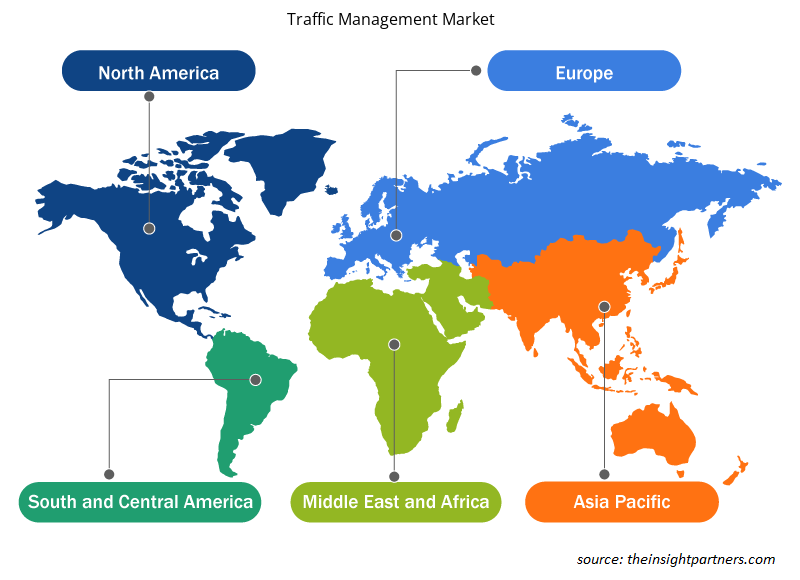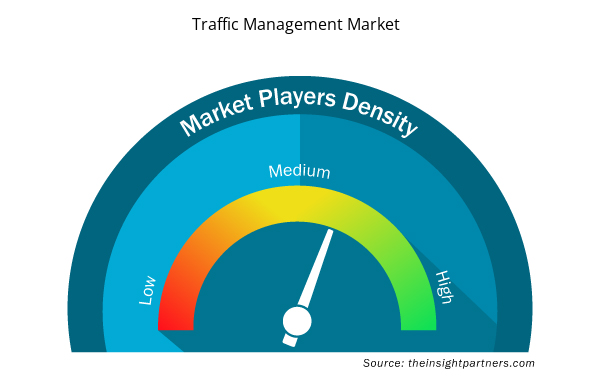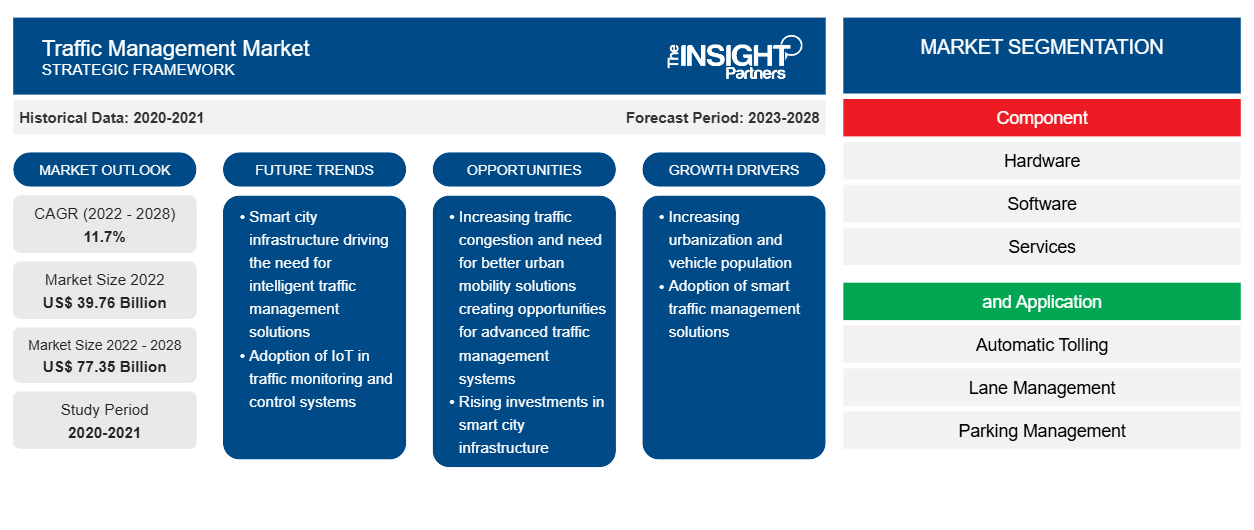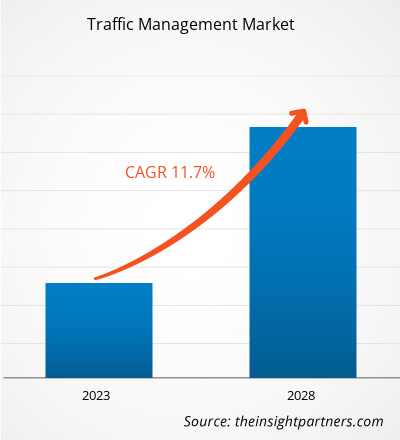Si prevede che il mercato della gestione del traffico raggiungerà i 77.346,44 milioni di dollari entro il 2028, rispetto ai 39.756,74 milioni di dollari del 2022; si prevede una crescita a un CAGR dell'11,7% dal 2022 al 2028.
La maggior parte dei paesi ha assistito a una drastica urbanizzazione nel corso degli anni, che ha portato a reti stradali complesse e ad un'elevata congestione. La crescente popolazione urbana, unita all'aumento della proprietà di veicoli privati, aumenta il numero di veicoli su strada. La popolazione di Mumbai, in India, è aumentata da 18,5 milioni nel 2011 a 20,4 milioni nel 2020, mentre il numero di veicoli privati è quasi raddoppiato durante questo periodo. A causa di tali fattori e per porvi rimedio, si stima una crescita del mercato della gestione del traffico . Inoltre, i servizi di ride-hailing degli aggregatori di taxi, come Uber , Grab, Ola e Lyft , sono aumentati a un ritmo rapido. Tali servizi hanno sostituito i sistemi di trasporto di massa, portando a un aumento dei veicoli su strada. Questi fattori stanno costringendo le autorità governative ad avvicinarsi agli operatori del mercato della gestione del traffico per soluzioni efficaci. La congestione del traffico può essere efficacemente ridotta con un solido sistema di gestione del traffico, comprendente software, sensori, telecamere e pannelli di visualizzazione. Questi sistemi possono essere installati su una strada esistente senza i requisiti di modifica infrastrutturale. Allo stesso modo, un sistema di gestione delle corsie può gestire efficacemente il flusso del traffico aprendo o chiudendo le corsie, a seconda del tasso di traffico in ogni momento. Considerando i vantaggi offerti dai sistemi di gestione del traffico, si prevede che il rapido tasso di urbanizzazione aumenterà notevolmente le dimensioni del mercato della gestione del traffico.
Impatto della pandemia di COVID-19 sulla crescita del mercato della gestione del traffico
L'epidemia di COVID-19 ha sconvolto settori verticali quali automotive, produzione, energia ed energia, aerospaziale e difesa, edilizia nel 2020. La continua crescita del numero di pazienti COVID ha costretto le autorità governative negli Stati Uniti e in altri paesi a imporre rigidi lockdown nei primi tre trimestri del 2020. Ciò ha portato a un calo significativo dei trasporti in tutti i paesi. L'implementazione di misure di contenimento come divieti commerciali, restrizioni di viaggio e limitazioni della forza lavoro ha avuto un impatto sulle attività di produzione, fornitura e vendita di varie aziende, comprese le aziende che forniscono hardware, software e servizi di gestione del traffico. Il settore manifatturiero ha subito gravi perdite a causa di chiusure temporanee delle fabbriche e bassi volumi di produzione, che hanno anche ostacolato la produzione di sistemi hardware di gestione del traffico. Negli Stati Uniti, il governo federale e statale si è concentrato maggiormente sulla lotta alla pandemia; di conseguenza, l'installazione di hardware e software di gestione del traffico è stata temporaneamente sospesa. Il settore europeo della gestione del traffico è stato duramente colpito a causa di una diminuzione di circa il 20% della spesa per progetti infrastrutturali, con conseguenti ritardi e interruzioni di diversi progetti di città intelligenti e strade intelligenti. I prezzi più alti dei semiconduttori e le supply chain interrotte hanno ulteriormente aggravato la situazione. Tuttavia, il mercato della gestione del traffico ha iniziato a registrare una crescita positiva nel quarto trimestre del 2020.
Personalizza questo report in base alle tue esigenze
Riceverai la personalizzazione gratuita di qualsiasi report, comprese parti di questo report, o analisi a livello nazionale, pacchetto dati Excel, oltre a usufruire di grandi offerte e sconti per start-up e università
- Scopri le principali tendenze di mercato in questo rapporto.Questo campione GRATUITO includerà analisi di dati che spaziano dalle tendenze di mercato alle stime e alle previsioni.
Approfondimenti di mercato – Mercato della gestione del traffico
Il mondo sta assistendo a un boom di dispositivi connessi e diversi paesi stanno investendo nello sviluppo di città intelligenti. Le città intelligenti sono aree urbane tecnologicamente avanzate che impiegano una varietà di sensori e metodi elettronici per raccogliere dati e utilizzarli per il miglioramento della località. Le città intelligenti sono progettate con piani a lungo termine per la gestione del traffico ottimizzando i trasporti e la logistica e riducendo la congestione. Quindi, insieme alle città intelligenti, i paesi stanno anche investendo nello sviluppo di strade intelligenti per garantire un pendolarismo più sicuro. Sulle strade intelligenti, diversi tipi di sensori e hardware raccolgono dati multivariati che vengono utilizzati per monitorare il traffico. I dati possono anche essere condivisi con i veicoli che viaggiano sulla strada, consentendo ai subacquei e ai pendolari di prendere decisioni informate. Quindi, ci si può aspettare che la crescente adozione di città intelligenti e strade intelligenti aumenti le dimensioni del mercato della gestione del traffico.
Approfondimenti basati sui componenti
Il mercato della gestione del traffico è segmentato in base a componente, applicazione e geografia. Il mercato, per componente, è segmentato in hardware, software e servizi. Il mercato dell'hardware è ulteriormente segmentato in telecamere, pannelli di visualizzazione e sensori; inoltre, il mercato del software è diviso in cloud e on-premise. Diverse agenzie governative hanno investito nell'aggiornamento del loro hardware di gestione del traffico. La crescente urbanizzazione e l'aumento della proprietà di automobili hanno gravato sulle carreggiate urbane. Pertanto, le autorità si affidano a telecamere moderne per una migliore manutenzione del flusso del traffico e per garantire la sicurezza. Le telecamere di riconoscimento automatico delle targhe (ANPR) vengono sempre più utilizzate per identificare i trasgressori o per localizzare i veicoli durante le indagini sugli incidenti. Sono spesso abbinate a sensori laser, per determinare la velocità di un veicolo.
Per applicazione, il mercato della gestione del traffico è segmentato in pedaggio automatico, gestione delle corsie, gestione dei parcheggi , sorveglianza, gestione dei segnali stradali e altri. In base alla geografia, il mercato è principalmente segmentato in Nord America, Europa, Asia Pacifico (APAC), Medio Oriente e Africa (MEA) e Sud America (SAM). IBM Corporation; Cisco Systems, Inc.; Siemens AG; Hangzhou Hikvision Digital Technology Co., Ltd.; e Dahua Technology Co., Ltd. sono tra i principali attori del mercato della gestione del traffico.
Approfondimenti regionali sul mercato della gestione del traffico
Le tendenze regionali e i fattori che influenzano il Traffic Management Market durante il periodo di previsione sono stati ampiamente spiegati dagli analisti di Insight Partners. Questa sezione discute anche i segmenti e la geografia del Traffic Management Market in Nord America, Europa, Asia Pacifico, Medio Oriente e Africa e Sud e Centro America.

- Ottieni i dati specifici regionali per il mercato della gestione del traffico
Ambito del rapporto di mercato sulla gestione del traffico
| Attributo del report | Dettagli |
|---|---|
| Dimensioni del mercato nel 2022 | 39,76 miliardi di dollari USA |
| Dimensioni del mercato entro il 2028 | 77,35 miliardi di dollari USA |
| CAGR globale (2022 - 2028) | 11,7% |
| Dati storici | 2020-2021 |
| Periodo di previsione | 2023-2028 |
| Segmenti coperti | Per componente
|
| Regioni e Paesi coperti | America del Nord
|
| Leader di mercato e profili aziendali chiave |
|
Densità degli attori del mercato della gestione del traffico: comprendere il suo impatto sulle dinamiche aziendali
Il mercato del Traffic Management Market sta crescendo rapidamente, spinto dalla crescente domanda degli utenti finali dovuta a fattori quali l'evoluzione delle preferenze dei consumatori, i progressi tecnologici e una maggiore consapevolezza dei vantaggi del prodotto. Con l'aumento della domanda, le aziende stanno ampliando le loro offerte, innovando per soddisfare le esigenze dei consumatori e capitalizzando sulle tendenze emergenti, il che alimenta ulteriormente la crescita del mercato.
La densità degli operatori di mercato si riferisce alla distribuzione di aziende o società che operano in un particolare mercato o settore. Indica quanti concorrenti (operatori di mercato) sono presenti in un dato spazio di mercato in relazione alle sue dimensioni o al valore di mercato totale.
Le principali aziende che operano nel mercato della gestione del traffico sono:
- Comunicazioni Axis AB
- Cisco Systems, Inc.
- Società cubica
- Dahua Technology Co., Ltd.
- Azienda: Hangzhou Hikvision Digital Technology Co., Ltd.
Disclaimer : le aziende elencate sopra non sono classificate secondo un ordine particolare.

- Ottieni una panoramica dei principali attori del mercato della gestione del traffico
Gli operatori del mercato della gestione del traffico si concentrano principalmente sullo sviluppo di prodotti avanzati ed efficienti.
- Nel 2021, Dahua Technology ha annunciato lo sviluppo di una soluzione completa di gestione intelligente del traffico, sviluppata combinando videosorveglianza con intelligenza artificiale, ANPR, fusione di immagini, realtà aumentata e altre tecnologie all'avanguardia per soddisfare le diverse esigenze dei moderni dipartimenti di controllo del traffico.
- Nel 2021, Hikvision, un fornitore di soluzioni IoT specializzato in telecamere, ha presentato la telecamera All-Rounder ITS, il suo prodotto di traffico più recente pensato per migliorare la sicurezza stradale e il flusso del traffico. La telecamera ha combinato una varietà di talenti e capacità, tra cui rilevamento della velocità, rilevamento delle violazioni del codice stradale, identificazione automatica delle targhe e analisi degli attributi del veicolo, il tutto in un unico pacchetto.
- Analisi storica (2 anni), anno base, previsione (7 anni) con CAGR
- Analisi PEST e SWOT
- Valore/volume delle dimensioni del mercato - Globale, regionale, nazionale
- Industria e panorama competitivo
- Set di dati Excel



Report Coverage
Revenue forecast, Company Analysis, Industry landscape, Growth factors, and Trends

Segment Covered
This text is related
to segments covered.

Regional Scope
North America, Europe, Asia Pacific, Middle East & Africa, South & Central America

Country Scope
This text is related
to country scope.
Domande frequenti
The traffic management market is expected to reach US$ 77,346.44 million by 2028.
The hardware segment led the traffic management market with a significant share in 2021. It is further expected to dominate the market share over the forecast period. However, software segment is expected to be the fastest growing.
India, China and Italy are expected to register high growth rates during the forecast period.
The US held the largest market share in 2021, followed by Germany.
Asia Pacific is the fastest growing regional market, followed by Europe.
The key players, holding majority shares, in traffic management market includes IBM Corporation; Cisco Systems, Inc.; Siemens AG; Hangzhou Hikvision Digital Technology Co., Ltd.; and Dahua Technology Co., Ltd.
Artificial Intelligence (AI) and Machine Learning (ML) are expected to play a crucial role in the future of the traffic management market. The application of AI and ML in traffic management is still quite nascent, and most countries are yet to adopt the same. However that scenario is changing fast, primarily due to the increasing number of connected cars.
Traffic management market is being driven by the rising urbanization, increasing congestion and growing investment in infrastructure development. Traffic management systems can be installed on an existing road without the requirements of infrastructural modification and thus can greatly aid in reducing congestion.
The global traffic management market was estimated to be USD 39,756.74 Million in 2021, and is expected to grow at a CAGR of 11.7%, during the forecast period 2022 - 2028.
The incremental growth, expected to be recorded for the traffic management market during the forecast period, is US$ 37,589.70 million.
Trends and growth analysis reports related to Technology, Media and Telecommunications : READ MORE..
The List of Companies - Traffic Management Market
- Axis Communications AB
- Cisco Systems, Inc.
- Cubic Corporation
- Dahua Technology Co., Ltd.
- Hangzhou Hikvision Digital Technology Co., Ltd.
- IBM Corporation
- SGS SA
- Siemens AG
- SNC-Lavalin Group
- Teledyne FLIR LLC
The Insight Partners performs research in 4 major stages: Data Collection & Secondary Research, Primary Research, Data Analysis and Data Triangulation & Final Review.
- Data Collection and Secondary Research:
As a market research and consulting firm operating from a decade, we have published and advised several client across the globe. First step for any study will start with an assessment of currently available data and insights from existing reports. Further, historical and current market information is collected from Investor Presentations, Annual Reports, SEC Filings, etc., and other information related to company’s performance and market positioning are gathered from Paid Databases (Factiva, Hoovers, and Reuters) and various other publications available in public domain.
Several associations trade associates, technical forums, institutes, societies and organization are accessed to gain technical as well as market related insights through their publications such as research papers, blogs and press releases related to the studies are referred to get cues about the market. Further, white papers, journals, magazines, and other news articles published in last 3 years are scrutinized and analyzed to understand the current market trends.
- Primary Research:
The primarily interview analysis comprise of data obtained from industry participants interview and answers to survey questions gathered by in-house primary team.
For primary research, interviews are conducted with industry experts/CEOs/Marketing Managers/VPs/Subject Matter Experts from both demand and supply side to get a 360-degree view of the market. The primary team conducts several interviews based on the complexity of the markets to understand the various market trends and dynamics which makes research more credible and precise.
A typical research interview fulfils the following functions:
- Provides first-hand information on the market size, market trends, growth trends, competitive landscape, and outlook
- Validates and strengthens in-house secondary research findings
- Develops the analysis team’s expertise and market understanding
Primary research involves email interactions and telephone interviews for each market, category, segment, and sub-segment across geographies. The participants who typically take part in such a process include, but are not limited to:
- Industry participants: VPs, business development managers, market intelligence managers and national sales managers
- Outside experts: Valuation experts, research analysts and key opinion leaders specializing in the electronics and semiconductor industry.
Below is the breakup of our primary respondents by company, designation, and region:

Once we receive the confirmation from primary research sources or primary respondents, we finalize the base year market estimation and forecast the data as per the macroeconomic and microeconomic factors assessed during data collection.
- Data Analysis:
Once data is validated through both secondary as well as primary respondents, we finalize the market estimations by hypothesis formulation and factor analysis at regional and country level.
- Macro-Economic Factor Analysis:
We analyse macroeconomic indicators such the gross domestic product (GDP), increase in the demand for goods and services across industries, technological advancement, regional economic growth, governmental policies, the influence of COVID-19, PEST analysis, and other aspects. This analysis aids in setting benchmarks for various nations/regions and approximating market splits. Additionally, the general trend of the aforementioned components aid in determining the market's development possibilities.
- Country Level Data:
Various factors that are especially aligned to the country are taken into account to determine the market size for a certain area and country, including the presence of vendors, such as headquarters and offices, the country's GDP, demand patterns, and industry growth. To comprehend the market dynamics for the nation, a number of growth variables, inhibitors, application areas, and current market trends are researched. The aforementioned elements aid in determining the country's overall market's growth potential.
- Company Profile:
The “Table of Contents” is formulated by listing and analyzing more than 25 - 30 companies operating in the market ecosystem across geographies. However, we profile only 10 companies as a standard practice in our syndicate reports. These 10 companies comprise leading, emerging, and regional players. Nonetheless, our analysis is not restricted to the 10 listed companies, we also analyze other companies present in the market to develop a holistic view and understand the prevailing trends. The “Company Profiles” section in the report covers key facts, business description, products & services, financial information, SWOT analysis, and key developments. The financial information presented is extracted from the annual reports and official documents of the publicly listed companies. Upon collecting the information for the sections of respective companies, we verify them via various primary sources and then compile the data in respective company profiles. The company level information helps us in deriving the base number as well as in forecasting the market size.
- Developing Base Number:
Aggregation of sales statistics (2020-2022) and macro-economic factor, and other secondary and primary research insights are utilized to arrive at base number and related market shares for 2022. The data gaps are identified in this step and relevant market data is analyzed, collected from paid primary interviews or databases. On finalizing the base year market size, forecasts are developed on the basis of macro-economic, industry and market growth factors and company level analysis.
- Data Triangulation and Final Review:
The market findings and base year market size calculations are validated from supply as well as demand side. Demand side validations are based on macro-economic factor analysis and benchmarks for respective regions and countries. In case of supply side validations, revenues of major companies are estimated (in case not available) based on industry benchmark, approximate number of employees, product portfolio, and primary interviews revenues are gathered. Further revenue from target product/service segment is assessed to avoid overshooting of market statistics. In case of heavy deviations between supply and demand side values, all thes steps are repeated to achieve synchronization.
We follow an iterative model, wherein we share our research findings with Subject Matter Experts (SME’s) and Key Opinion Leaders (KOLs) until consensus view of the market is not formulated – this model negates any drastic deviation in the opinions of experts. Only validated and universally acceptable research findings are quoted in our reports.
We have important check points that we use to validate our research findings – which we call – data triangulation, where we validate the information, we generate from secondary sources with primary interviews and then we re-validate with our internal data bases and Subject matter experts. This comprehensive model enables us to deliver high quality, reliable data in shortest possible time.


 Ottieni un campione gratuito per questo repot
Ottieni un campione gratuito per questo repot